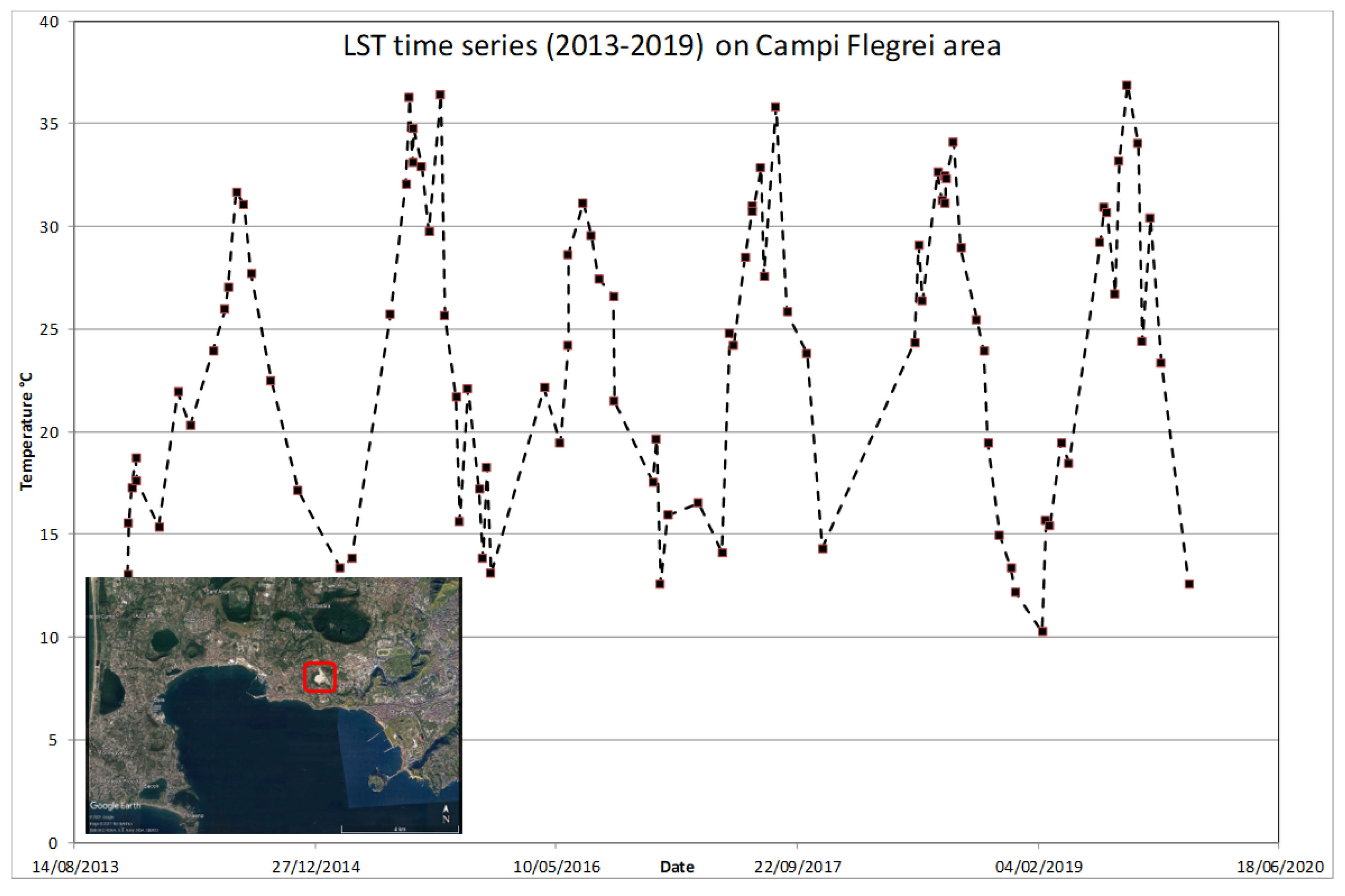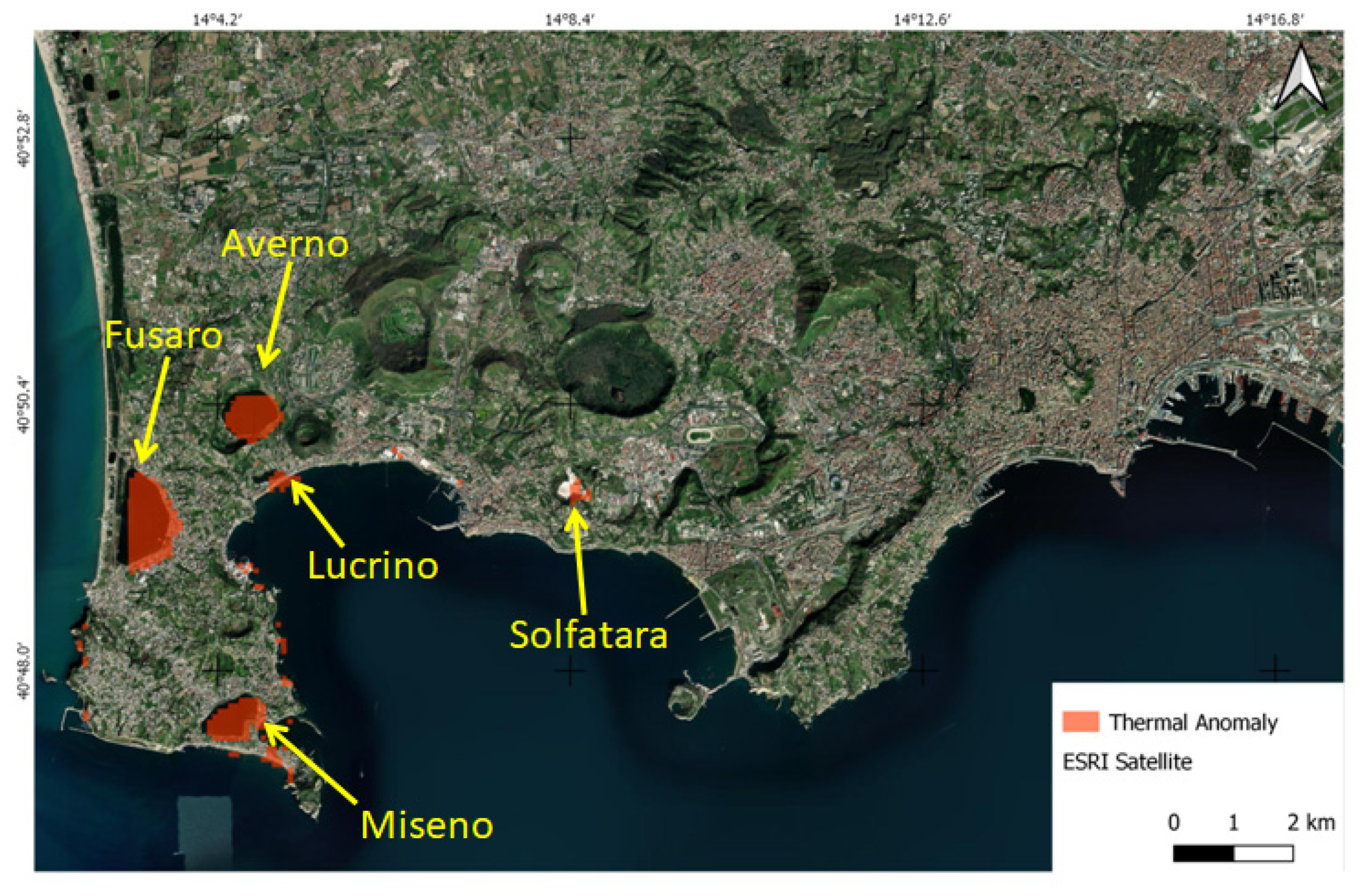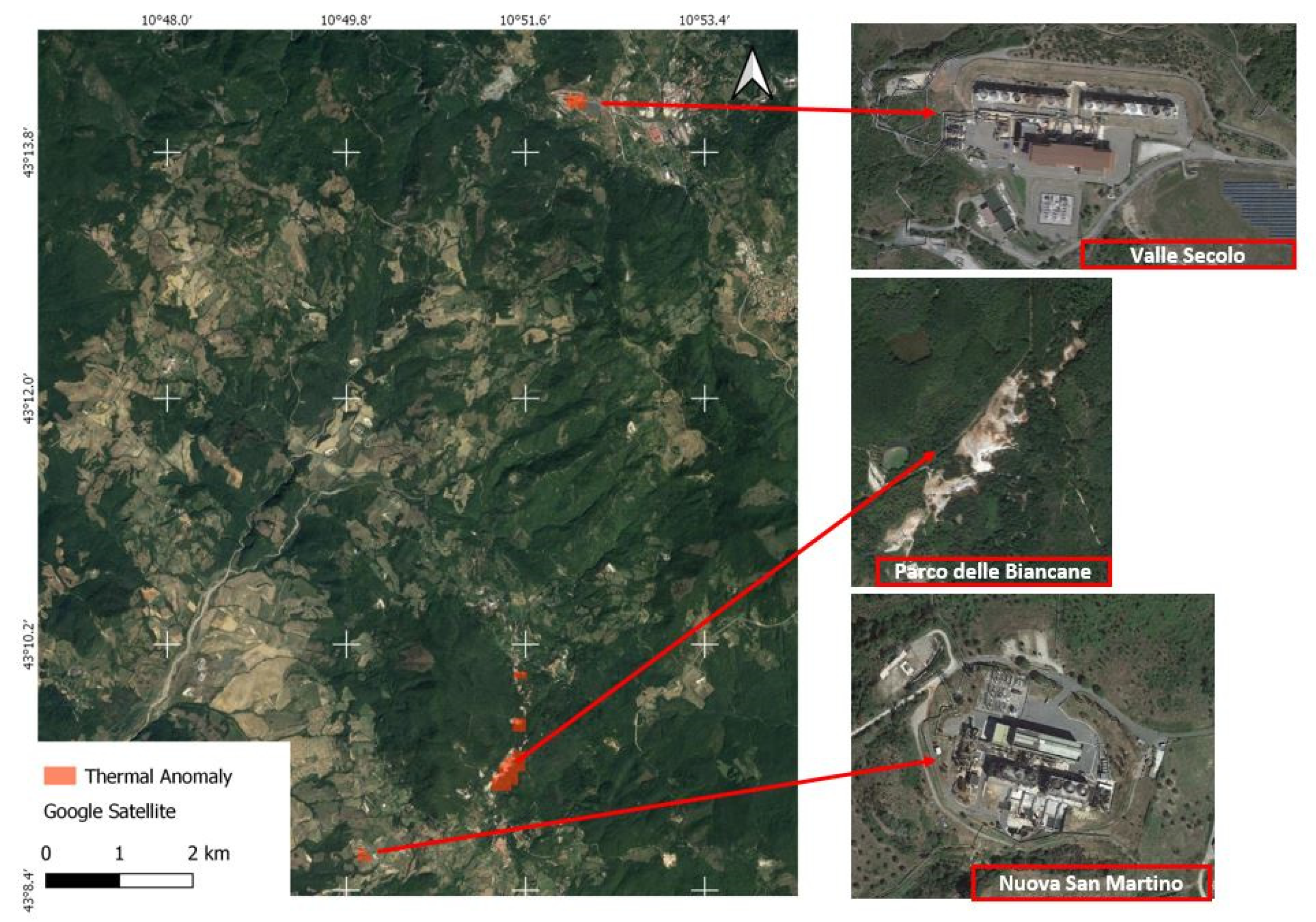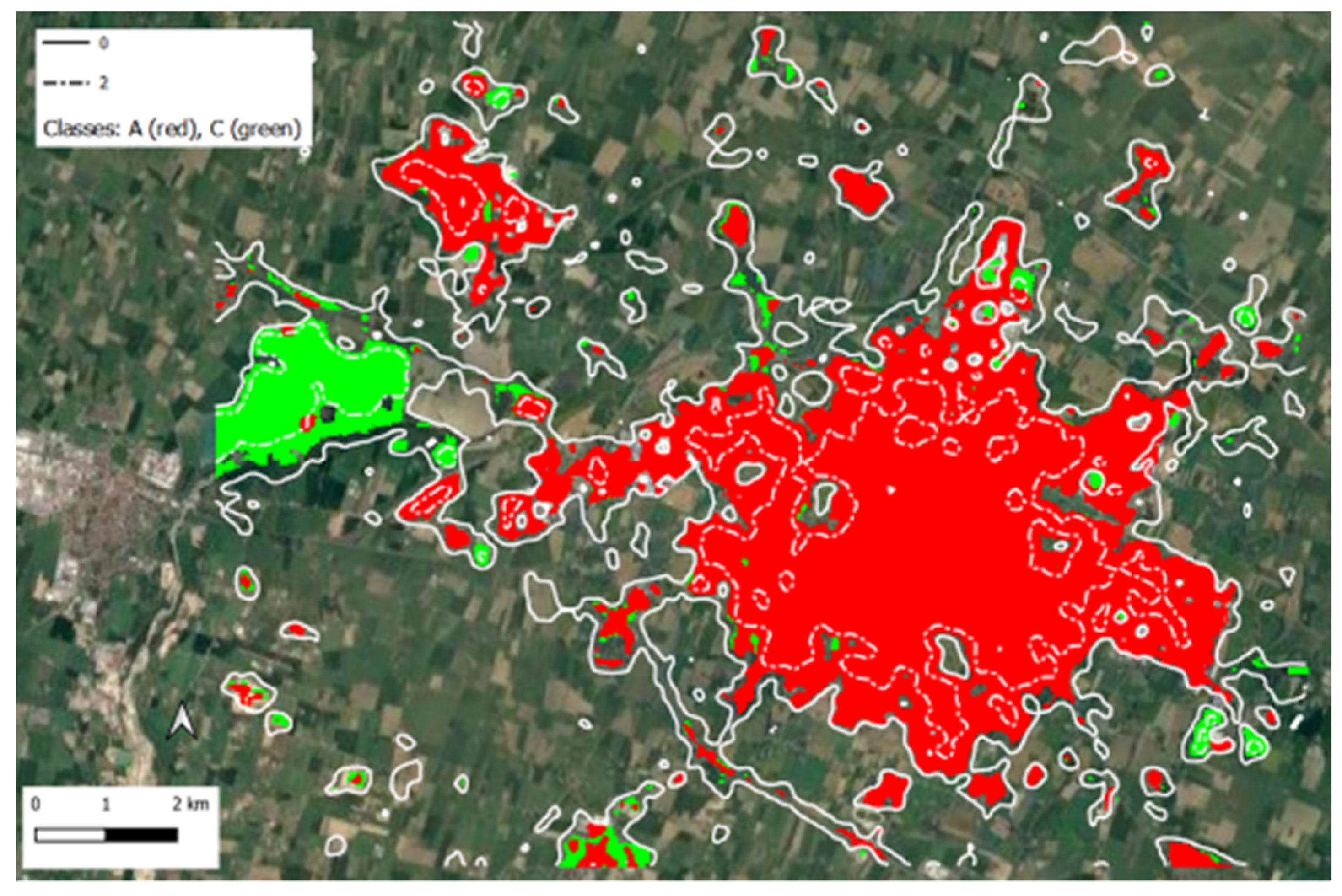The Use of Satellite TIR Time Series for Thermal Anomalies’ Detection on Natural and Urban Areas †
Abstract
:1. Introduction
2. Materials and Methods
- for Solfatara-Campi Flegrei, the ground measurements collected by permanent thermal cameras installed in Solfatara volcano. The images have been reprojected to have the same point of view as the satellite;
- for Parco delle Biancane, the TIR images acquired using thermal cameras mounted on drones and collected during three separated field campaigns synchronized with satellite passages;
- for Modena, weather stations at the 4 stations around Modena city.
3. Results and Discussion
4. Conclusions
- the methodologies used to obtain LST also produce reliable temperature estimates in the very particular case of geothermal anomalies and are usable for near ground air temperature trends’ analysis;
- the PCA allows us to extract the dominant patterns within the time series to detect thermal anomalies, offering a good and easy way to produce very detailed maps of the thermal anomalies in both geothermal areas and in urban areas (UHI);
- the PCA allows for the differentiation of the surface cover without using other re-mote sensing images in VIS/NIR or auxiliary classification products. This differentiation improves the analysis of the thermal behavior of the surfaces.
Author Contributions
Funding
Institutional Review Board Statement
Informed Consent Statement
Data Availability Statement
Acknowledgments
Conflicts of Interest
References
- Buongiorno, M.F.; Pieri, D.; Silvestri, M. Thermal analysis of volcanoes based on 10 years of ASTER data on Mt. Etna. In Thermal Infrared Remote Sensing; Springer: Dordrecht, The Netherlands, 2013; pp. 409–428. [Google Scholar]
- Pieri, D.; Abrams, M. ASTER watches the world’s volcanoes: A new paradigm for volcanological observations from orbit. J. Volcanol. Geotherm. Res. 2004, 135, 13–28. [Google Scholar] [CrossRef]
- Silvestri, M.; Romaniello, V.; Hook, S.; Musacchio, M.; Teggi, S.; Buongiorno, M.F. First Comparisons of Surface Temperature Estimations between ECOSTRESS, ASTER and Landsat 8 over Italian Volcanic and Geothermal Areas. Remote Sens. 2020, 12, 184. [Google Scholar] [CrossRef] [Green Version]
- Fridleifsson, I.B.; Bertani, R.; Huenges, E.; Lund, J.W.; Ragnarsson, A.M.; Rybach, L. The possible role and contribution of geothermal energy to the mitigation of climate change. In Proceedings of the IPCC Scoping Meeting on Renewable Energy Sources, Luebeck, Germany, 20 January 2008; Volume 20, pp. 59–80. [Google Scholar]
- Howari, F. Prospecting for geothermal energy through satellite based thermal data: Review and the way forward. Glob. J. Environ. Sci. Manag. 2015, 1, 265–274. [Google Scholar]
- Qin, Q.; Zhang, N.; Nan, P.; Chai, L. Geothermal area detection using Landsat ETM+ thermal infrared data and its mechanistic analysis-A case study in Tengchong, China. Int. J. Appl. Earth Obs. Geoinf. 2011, 13, 552–559. [Google Scholar] [CrossRef]
- Voogt, J.A.; Oke, T.R. Thermal remote sensing of urban climates. Remote Sens. Environ. 2003, 86, 370–384. [Google Scholar] [CrossRef]
- Sobrino, J.A.; Oltra-Carrió, R.; Sòria, G.; Bianchi, R.; Paganini, M. Impact of spatial resolution and satellite overpass time on evaluation of the surface urban heat island effects. Remote Sens. Environ. 2012, 117, 50–56. [Google Scholar] [CrossRef]
- Gillespie, A.; Rokugawa, S.; Matsunaga, T.; Cothern, J.S.; Hook, S.; Kahle, A.B. A temperature and emissivity separation algorithm for advanced spaceborne thermal emission and reflection radiometer (ASTER) images. IEEE Trans. Geosci. Remote Sens. 1998, 36, 1113–1126. [Google Scholar] [CrossRef]
- Silvestri, M.; Marotta, E.; Buongiorno, M.F.; Avvisati, G.; Belviso, P.; Bellucci Sessa, E.; Caputo, T.; Longo, V.; De Leo, V.; Teggi, S. Monitoring of Surface Temperature on Parco delle Biancane (Italian Geothermal Area) Using Optical Satellite Data, UAV and Field Campaigns. Remote Sens. 2020, 12, 2018. [Google Scholar] [CrossRef]
- Caputo, T.; Bellucci Sessa, E.; Silvestri, M.; Buongiorno, M.F.; Musacchio, M.; Sansivero, F.; Vilardo, G. Surface temperature multiscale monitoring by thermal infrared satellite and ground images at Campi Flegrei volcanic area (Italy). Remote Sens. 2019, 11, 1007. [Google Scholar] [CrossRef] [Green Version]








| Data | Number of Processed Images | ||
|---|---|---|---|
| Solfatara-Campi Flefrei | Parco delle Biancane | Modena City | |
| LST-ASTER | 40 | 20 | NA |
| LST-Landsat 8 | 55 | 40 | 43 |
| TOTAL LST | 95 | 60 | 43 |
Publisher’s Note: MDPI stays neutral with regard to jurisdictional claims in published maps and institutional affiliations. |
© 2021 by the authors. Licensee MDPI, Basel, Switzerland. This article is an open access article distributed under the terms and conditions of the Creative Commons Attribution (CC BY) license (https://creativecommons.org/licenses/by/4.0/).
Share and Cite
Silvestri, M.; Rabuffi, F.; Musacchio, M.; Teggi, S.; Buongiorno, M.F. The Use of Satellite TIR Time Series for Thermal Anomalies’ Detection on Natural and Urban Areas. Eng. Proc. 2021, 5, 5. https://doi.org/10.3390/engproc2021005005
Silvestri M, Rabuffi F, Musacchio M, Teggi S, Buongiorno MF. The Use of Satellite TIR Time Series for Thermal Anomalies’ Detection on Natural and Urban Areas. Engineering Proceedings. 2021; 5(1):5. https://doi.org/10.3390/engproc2021005005
Chicago/Turabian StyleSilvestri, Malvina, Federico Rabuffi, Massimo Musacchio, Sergio Teggi, and Maria Fabrizia Buongiorno. 2021. "The Use of Satellite TIR Time Series for Thermal Anomalies’ Detection on Natural and Urban Areas" Engineering Proceedings 5, no. 1: 5. https://doi.org/10.3390/engproc2021005005
APA StyleSilvestri, M., Rabuffi, F., Musacchio, M., Teggi, S., & Buongiorno, M. F. (2021). The Use of Satellite TIR Time Series for Thermal Anomalies’ Detection on Natural and Urban Areas. Engineering Proceedings, 5(1), 5. https://doi.org/10.3390/engproc2021005005






